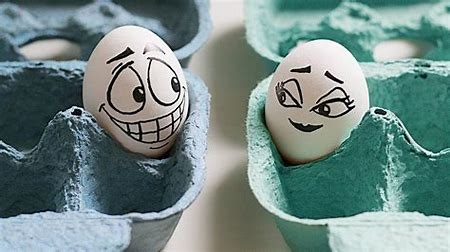MOST EGGS XCELLENT!
Hares a few facts - so don’t get shell shocked and don’t egg-nore them, as some of them will crack you up – read on if you dare to whisk it!
- Easter was declared a moveable feast by early Christians with Easter Sunday on the first Sunday after the first full moon after the spring equinox... This was not the real full moon but the “ecclesiastical full moon” calculated by the church.
- In the UK, the Easter Act 1928 set out to fix the date of Easter, but this still awaits agreement from all the Anglican churches.
- The earliest known reference to Easter eggs was in the 16th century when the term referred to blown or hard-boiled eggs with decorations.
- The Easter egg is said to symbolise and represent joy, celebration and new life.
- The name Easter owes its origin to Eostre or Eastre, an Anglo-Saxon goddess of light and the dawn who symbolizes the hare and the egg and who was honoured at pagan festivals celebrating the arrival of spring.
- The custom of giving eggs at Easter has been traced back to Egyptians, Persians, Gauls, Greeks and Romans, for whom the egg was a symbol of life.
- The UK’s first chocolate egg was produced in 1873 by Fry’s of Bristol.
- Every child in the UK receives an average of 8.8 Easter eggs every year – double their recommended calorie intake for a whole week.
- Are you an ears, arms or tail person? Seventy-six percent of people eat the ears on the chocolate bunny first, 5 percent go for the feet and 4 percent for the tail.
- Temptation can be too much and 43 per cent of kids say they eat their first chocolate egg before Easter Sunday, but the average time for children to eat their first Easter egg is 11am on Easter Sunday morning.
- Almost one in five children (19 per cent) say they’ve made themselves ill by eating too much chocolate over the Easter holidays.
- With all those chocolate eggs for family, relatives, loved ones and friends, it should be no surprise that households spend an average of £75 on Easter treats each year.
- Sales at Easter time make up 10 per cent of UK chocolate spending for the whole year.
- In 2012, London hosted the world’s biggest-ever Easter egg hunt.
- The tallest Easter egg chocolate was made in Italy in 2011. It stood at 10.39 meters and weighed an astounding 7,200 kg, it was taller than a giraffe and heavier than an elephant. But Portugal is the home of the largest decorated Easter egg, which reached almost 15m in height and 8m in diameter when it was made in 2008.
- The White House hosts an Easter Egg Roll on the front lawn each year. This tradition was started by President Rutherford B. Hayes in 1878.
- The largest ever Easter egg hunt was in Florida, where 9,753 children searched for 501,000 eggs.
- The art of painting eggs is called pysanka, which originated in Ukraine. It involves using wax and dyes to colour the egg.
- In 2007, an Easter egg covered in diamonds sold for almost £9 million
- The exchange or giving of Easter eggs actually dates back to before Easter and the giving of eggs is considered a symbol of rebirth in many cultures.
- There used to be a tradition churches observed that resembled the game of "hot potato." Here, the priest would toss a hard-boiled egg to one of the choir boys. The boys would toss the egg amongst themselves and when the clock struck 12, whomever had the egg was the winner and got to keep the egg.
- Every hour, a cockerel made of jewels pops up from the top of the Faberge egg, flaps its wings four times, nods its head three times and makes a crowing noise. The gold-and-pink enamel egg was made by the Russian royal family as an engagement gift for French aristocrat Baron Edouard de Rothschild.
- The world’s most popular egg-shaped chocolate is Cadbury’s Creme Egg. Workers at Cadbury in Birmingham produce 1.5 million of these every day.
- On Easter Sunday in Scotland and North-East England, some people have great fun rolling painted eggs down steep hills. This is also popular in parts of America, where people push the egg along with a spoon.
- Next to Halloween, Easter is the biggest sweet consuming holiday of the year. Good thing they are almost six months apart, perfect for your yearly dentist check-ups!
- Easter is the celebration of the resurrection of Christ; it is the oldest Christian holiday and one of the most important days of the year.
- The idea of the Easter bunny giving sweets and eggs is said to have originated in Germany during the middle ages.
However, you choose to celebrate make it Egg-ceptional!
